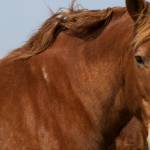Why Is Obesity Bad for Your Horse?

“When Taffy sticks her head out of the stall and whinnies for her grain, I just can’t resist giving her a little extra.”
“I think my pony looks cute when he’s a little bit chubby!”
For many horse owners, the easiest way to express their affection for their horses is by feeding them. Grain meals, apples and carrots, special horse treats with appealing names, crunchy peppermint candies…it all adds up, and pretty soon the equine can be several hundred pounds heavier than its optimal weight. At this point, “looking cute” has become unhealthy. The obese horse is at a high risk for laminitis, joint problems, exercise intolerance, and insulin resistance, among other conditions.
Obesity is a pro-inflammatory state that plays an important role in the pathogenesis of insulin resistance (IR). Insulin sensitivity is reduced as body fat mass increases, and is often restored as body fat is reduced. However, body weight is not the only factor in IR, as some horses can show IR at moderate weight and some obese horses are not affected. Several factors including genetic and environmental influences lead to obesity, but an imbalance between energy intake and output is particularly important.
A horse’s energy requirement is built around body maintenance, exercise, growth, reproductive status, environmental conditions, and genetic factors related to the horse’s particular metabolism. Management of the obese horse requires both reduced energy intake and increased energy output.
Reduced energy intake can be accomplished by eliminating calorie-dense grain (and treats) and restricting forage. A low-calorie balancer pellet can be fed to provide vitamins and minerals previously supplied by grain, without the excess calories. To decrease intake of forage, owners can make use of a grazing muzzle, a drylot, and very brief grazing periods several times a day.
Don’t assume that keeping the horse in a stall or drylot for several hours each day will decrease intake, as restricted horses will put their pasture time to good use and consume almost as much grass in a few hours as their full-pasture counterparts eat in a whole day. For this reason, use of a grazing muzzle is often more effective at reducing intake than moderate restriction of grazing time.
Keeping the horse completely off pasture and feeding a low-carbohydrate hay allows the owner to keep track of exactly how much the horse is eating. Alfalfa hay (lucerne) and early-cut hay with a high percentage of leaves and seeds should not be fed. Instead, a later-cut hay is a better choice because the more mature plants will include more stalks that are less digestible and therefore provide fewer calories. Soaking the hay for 30 minutes in hot water or 60 minutes in cold water before feeding will remove some of the water-soluble carbohydrates.
To decrease the horse’s weight, take a week or so to gradually decrease the amount the horse has been eating until he is being given 1.5% of his target body weight in hay every day. Don’t guess; weighing the hay is the only way to know how much to offer. If possible, feed hay in several small meals throughout the day, or use a slow-feeder net or bin to make the meals last longer. Stay with this level of feeding for a month or two. If the horse hasn’t lost much weight in that time, cut intake to 1.25% of body weight per day for another month. Don’t feed less than 1% of the horse’s target body weight per day. The change in body condition will be slow, with a reasonable rate of weight loss being 0.5 to 0.7% of body weight per week. It may take a loss of 60 to 75 lb (130 to 165 kg) to effect a reduction of one body condition score. Therefore, the change is a gradual one, often taking a number of weeks.
Increasing energy output will help with weight loss. Daily exercise (riding, driving, hand-walking, longeing, muzzled turnout with companions) should be increased gradually unless the horse is lame or unable to move with comfort.








